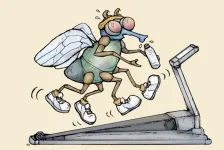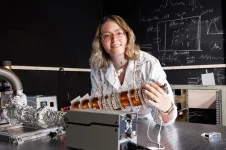(Press-News.org) Four in ten children in Central London who travelled to school by car switched to more active modes of transport, such as walking, cycling, or public transport, following the introduction of the Ultra-Low Emission Zone (ULEZ), according to new research. In the comparison area with no ULEZ, Luton, only two in ten children made this switch over the same period.
Car travel contributes to air pollution, a major cause of heart and lung diseases including asthma attacks. Beyond this, it limits children's opportunities for physical activity, hindering their development and mental health, and increasing their risk of obesity and chronic illnesses.
Despite UK guidelines recommending a daily average of 60 minutes of moderate-to-vigorous physical activity for school-aged children and adolescents, less than half (45%) of children aged 5-16 met these levels in 2021. One in three children aged 10-11 in the UK are overweight or obese.
In April 2019, London introduced the ULEZ to help improve air quality by reducing the number of vehicles on the road that do not meet emissions standards. According to Transport for London, the central London ULEZ reduced harmful nitrogen oxides by 35% and particulate matter by 15% in central London within the first 10 months of its introduction.
In a study published today in the International Journal of Behavioral Nutrition and Physical Activity, a team led by researchers at the University of Cambridge and Queen Mary University of London examined the impact of the ULEZ on how children travelled to school. The research was part of the CHILL study (Children’s Health in London and Luton).
The study examined data from almost 2,000 children aged six to nine years attending 84 primary schools in London and the control area, Luton. 44 schools were located with catchment areas within or bordering London’s ULEZ, and these were compared to a similar number in Luton and Dunstable (acting as a comparison group). The inclusion of the comparison site enabled the researchers to draw more robust conclusions and increased confidence in attributing the observed changes to the introduction of the ULEZ.
The researchers collected data from the period June 2018 to April 2019, prior to ULEZ implementation, and again in the period June 2019 to March 2020, the year after implementation of the ULEZ but prior to COVID-19-related school closures.
Among those children in London who travelled by car prior to the introduction of the ULEZ, four in 10 (42%) switched to active modes, while one in 20 (5%) switched from active to inactive modes.
In contrast, only two in ten (20%) children in Luton swapped from car travel to active modes, while a similar number (21%) switched from active to car travel. This means that children in London within the ULEZ were 3.6 times as likely to shift from travelling by car to active travel modes compared to those children in Luton and far less likely (0.11 times) to switch to inactive modes.
The impact of the ULEZ on switching to active travel modes was strongest for those children living more than half a mile (0.78km) from school. This was probably because many children who live closer to school already walked or cycled to school prior to the ULEZ and therefore there was more potential for change in those living further away from their school.
The study’s first author, Dr Christina Xiao from the Medical Research Council (MRC) Epidemiology Unit at the University of Cambridge, said: “The introduction of the ULEZ was associated with positive changes in how children travelled to school, with a much larger number of children moving from inactive to active modes of transport in London than in Luton.
“Given children's heightened vulnerability to air pollution and the critical role of physical activity for their health and development, financial disincentives for car use could encourage healthier travel habits among this young population, even if they do not necessarily target them.”
Joint senior author Dr Jenna Panter from the MRC Epidemiology Unit, University of Cambridge, said: “The previous government was committed to increasing the share of children walking to school by 2025 and we hope the new government will follow suit. Changing the way children travel to school can have significant effects on their levels of physical activity at the same time as bringing other co-benefits like improving congestion and air quality, as about a quarter of car trips during peak morning hours in London are made for school drop-offs.”
After ULEZ was introduced in Central London, the total number of vehicles on the roads fell by 9%, and by one-third (34%) for vehicles that failed to meet the required exhaust emission standards, with no clear evidence of traffic moving instead to nearby areas.
Joint senior author Professor Chris Griffiths from the Wolfson Institute of Population Health, Queen Mary University of London, said: “Establishing healthy habits early is critical to healthy adulthood and the prevention of disabling long term illness, especially obesity and the crippling diseases associated with it. The robust design of our study, with Luton as a comparator area, strongly suggests the ULEZ is driving this switch to active travel. This is evidence that Clean Air Zone intervention programmes aimed at reducing air pollution have the potential to also improve overall public health by addressing key factors that contribute to illness.”
Due to the introduction of COVID-19 restrictions in late March 2020, the study was paused in 2020/2021 and results are only reported for the first year of follow-up. However, as both London and Luton, the study areas, were similarly affected, the researchers believe this disruption is unlikely to have affected the results. The study has restarted following up with the children to examine the longer-term impacts of the ULEZ. This will identify if the changes they observed in the year following the introduction of the ULEZ persist.
The study was conducted in collaboration with Queen Mary University of London, Imperial College, University of Bedfordshire, University of Edinburgh, University of Oxford and University of Southern California and funded by the National Institute for Health Research Public Health Research (NIHR), NIHR Applied Research Collaboration North Thames, and Cambridge Trust.
Reference
Xiao, C et al. Children’s Health in London and Luton (CHILL) cohort: A 12-month natural experimental study of the effects of the Ultra Low Emission Zone on children’s travel to school. IJBNPA; 5 Sept 2024; DOI: 10.1186/s12966-024-01621-7
END
Children switch to walking and cycling to school after introduction of London’s Ultra-Low Emission Zone
2024-09-05
ELSE PRESS RELEASES FROM THIS DATE:
Three top ways to stop smoking
2024-09-05
A major new scientific review of evidence published in the journal Addiction has identified three top strategies for quitting smoking:
Varenicline -- a prescription drug sold under the brand names Chantix and Champix among others.
Cytisine -- a plant-based compound available under prescription in the United Kingdom, in Canada as an over-the-counter natural health product (Cravv®) and throughout central and eastern Europe.
Nicotine e-cigarettes.
These work best when combined with behavioural support, ...
Scientific review reveals top three effective ways to stop smoking
2024-09-05
A major new review of evidence by a team of scientists, including a University of Massachusetts Amherst public health researcher, has identified the three best strategies for quitting smoking:
Varenicline – a prescription drug sold under the brand names Chantix and Champix, among others.
Cytisine – a plant-based compound not widely available in the U.S. but sold as an over-the-counter natural health product (Cravv®) in Canada and throughout Central and Eastern Europe, and available under prescription in the United Kingdom.
Nicotine e-cigarettes.
The review, published ...
HudsonAlpha researchers awarded NIH grant to identify genetic contributors to rare diseases in children
2024-09-05
As genetic sequencing technology becomes more accessible and efficient, researchers have made significant strides in understanding the genetic underpinnings of various diseases. This knowledge has led to a surge in clinical applications of genetic testing, offering hope and improved outcomes for individuals affected by many genetic diseases and disorders. Despite these successes, scientists continue to try to improve genetic testing technologies, because many individuals with rare diseases remain undiagnosed even after current state-of-the-art genomic testing.
Scientists at the HudsonAlpha Institute for Biotechnology ...
The signals in your brain that tell you when It’s time to move
2024-09-05
A new study, published in Nature Communications this week, led by Jake Gavenas PhD, while he was a PhD student at the Brain Institute at Chapman University, and co-authored by two faculty members of the Brain Institute, Uri Maoz and Aaron Schurger, examines how the brain initiates spontaneous actions. In addition to demonstrating how spontaneous action emerges without environmental input, this study has implications for the origins of slow ramping of neural activity before movement onset—a commonly-observed but poorly understood ...
Hudson River Foundation awards $1.7 million to Cary Institute for river monitoring program
2024-09-04
(Millbrook, NY) The Hudson River Foundation for Science and Environmental Research (HRF) has awarded $1.7 million to Cary Institute of Ecosystem Studies to monitor the Hudson River’s lower food web for three years. The project is an integral component of the $6.5 million Hudson River Ecosystem Monitoring Program, a collaboration of HRF and New York State Department of Environmental Conservation (DEC) to develop and implement the next generation comprehensive ecosystem monitoring program on the Hudson.
Cary’s Chris Solomon will lead the Interim Lower Food Web Survey to provide ...
$7.5 million grant to guard against AI-driven misinformation
2024-09-04
BLOOMINGTON, Ind. — Indiana University researchers will lead a multi-institutional team of experts in areas such as informatics, psychology, communications and folklore to assess the role that artificial intelligence may play in strengthening the influence of online communications — including misinformation and radicalizing messages — under a $7.5 million grant from the U.S. Department of Defense.
The project is one of 30 recently funded by the department’s Multidisciplinary University ...
Seeing like a butterfly: Optical invention enhances camera capabilities
2024-09-04
UNIVERSITY PARK, Pa. — Butterflies can see more of the world than humans, including more colors and the field oscillation direction, or polarization, of light. This special ability enables them to navigate with precision, forage for food and communicate with one another. Other species, like the mantis shrimp, can sense an even wider spectrum of light, as well as the circular polarization, or spinning states, of light waves. They use this capability to signal a “love code,” which helps them find and be discovered by mates.
Inspired ...
Miniature treadmills accelerate studies of insects walking
2024-09-04
Fruit flies walking on miniature treadmills are helping scientists learn how the nervous system enables animals to move in an unpredictable and complex world.
Insights from using these fruit fly-sized treadmills were reported Aug. 30 in Current Biology, a Cell Press journal. Several videos of the flies running on the treadmills are available for viewing on the online research paper. The lead author is Brandon G. Pratt, a recent physiology and biophysics Ph.D. graduate of the University of Washington School of Medicine in Seattle and a National Science Foundation ...
UTA undergraduate researcher receives national honors
2024-09-04
A physics student at The University of Texas at Arlington studying ways to measure the mass of tiny particles called neutrinos has earned a prestigious national award for her research.
Senior Kara Stogsdill received the Outstanding Undergraduate Research Award from the Society of Physics Students, an organization of the American Institute of Physics. The award is given to students based on exceptional research achievements in any physics-related field.
Stogsdill’s research is part of the Project 8 Neutrino Mass Experiment, which includes faculty and students from UTA and 13 other universities and national laboratories ...
Pennington Biomedical's Greaux Healthy Initiative takes aim at childhood obesity
2024-09-04
Pennington Biomedical Research Center is formally launching Greaux Healthy, a public service initiative designed to help improve kids’ health at every age. Developed with funding from the State of Louisiana, Greaux Healthy implements 35 years of Pennington Biomedical research and discoveries to inform tools, resources and programing for children, parents, physicians and educators throughout the state.
The Greaux Healthy initiative is developing a wide variety of educational materials distinctly tailored to four priority populations, including expectant families and parents of infants, ...





